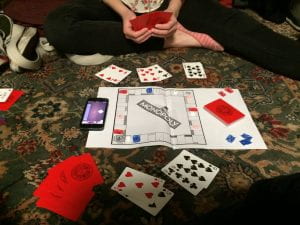Appropriation Game.
Materials:
-Deck of cards
-Player pieces from Sorry! (Or altoids?), 3 for each with one being the main piece
-Monopoly Board
-Houses from monopoly (Markers?)
-Deck of Playing Cards
-6 sided die
-A coin
Can be played with 2-4 players, probably the more the better.
Rules:
- Players start off on corners of the board, rolling to see who goes first. With 2 players they start on opposite corners, with 3 players do a coin toss to see which remaining corner the 3rd player starts in.
- Each player draws 6 cards from the pile
- Players role the die. Their marked piece must move the amount of spaces on the die, while the other 2 pieces can have the same amount of moves split between them
- When a player lands on a space an opponent piece is on, the player can ask that opponent for a card(# or face card) in their hand. If the opponent has said card, they must give it to the player. If the opponent does not have the asked for card, the player may draw one from the pile
- When a player makes a pair of cards, they place a marker on the space the bread winning piece is on.
- If a player lands on a space owned by an opponent, the opponent may choose a card at random from the players hand to shuffle back in to the deck.
- Landing on a ? space allows a player to draw a card
- The game is over when one player has 6 pairs

Artist Statement:
My inspiration for this game came while thinking about how the Dadaists during WWI were all trying to escape the conflicts in the world around them. They viewed the conflicts as pointless, and many time s now when I think of the conflicts going on in the world I am envious of the time when I was child and was not concerned with anything other than games or what was for dinner. This inspired me to make a game only using rules/pieces from games I played as a child, being Go Fish, Sorry!, and Monopoly.
The first iteration went decently well, but I found that people could split their moves up well enough to always avoid spaces owned by other players. This resulted in me making one piece consistently following the die, while the other two pieces could split the spaces. This ended up working very well, as during my next playtest I ran with my girlfriend, the pieces that split moves would at some point be barely passed by the opponents fixed piece. This gave a guaranteed opportunity to attack the opponent and keep the game moving.
